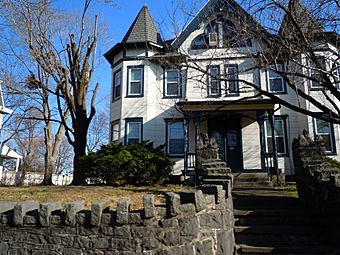Coopersburg Historic District facts for kids
Quick facts for kids |
|
|
Coopersburg Historic District
|
|
 |
|
| Location | Main St. and PA 309, Coopersburg, Pennsylvania |
|---|---|
| Area | 93 acres (38 ha) |
| Built | 1750 |
| Architect | Jordan, Genaah; Et al. |
| Architectural style | Colonial Revival, Queen Anne, Federal |
| NRHP reference No. | 82003798 |
| Added to NRHP | April 26, 1982 |
The Coopersburg Historic District is a special area in Coopersburg, Pennsylvania. It's like a living museum! This district is recognized as a national historic place. It helps us remember and protect important buildings from the past.
This historic district is located in Lehigh County, Pennsylvania. It includes 175 buildings that tell a story. These buildings are found in the main part of Coopersburg. They also spread into the nearby neighborhoods.
The buildings here show many different styles. You can see Colonial Revival, Queen Anne, and Federal designs. Each style has its own unique look.
Contents
What is a Historic District?
A historic district is a group of buildings, structures, or sites. They are important because of their history or architecture. These areas are officially recognized and protected. This helps keep their unique character for future generations.
Think of it like a special neighborhood. The buildings in it are old and have a story. They show us how people lived long ago. Protecting these districts helps us learn about our past. It also keeps our towns looking unique.
Exploring Coopersburg's Historic Buildings
The Coopersburg Historic District has many interesting buildings. Each one adds to the area's rich history. Let's look at some of the most notable ones.
Architectural Styles You'll See
The buildings in Coopersburg show different architectural styles. These styles were popular at different times.
- Colonial Revival: This style became popular in the late 1800s. It brought back designs from America's colonial past. You might see grand entrances and symmetrical shapes.
- Queen Anne: This style was popular in the late 1800s too. It's known for its towers, turrets, and decorative details. Often, these houses have different textures and colors.
- Federal: This style was common in the early 1800s. It's simpler than Queen Anne. Federal buildings often have balanced designs and elegant details.
Famous Buildings in the District
Many buildings stand out in the Coopersburg Historic District. They each have their own history.
- Norcross House (1790): This is one of the oldest buildings. It gives us a peek into life in the late 1700s.
- Barron House: This building once served as a social hall. It was used by the Coopersburg Fire Company. Imagine all the community events held there!
- Odd Fellows' Hall: This hall belonged to a fraternal organization. Groups like the Odd Fellows were important in communities long ago.
- Baldwin House Hotel (1856): Hotels were vital for travelers in the past. This building shows what a hotel looked like in the mid-1800s.
- Gander (or Boye) House: Another historic home with its own unique story.
- The Cooper Estate: This estate likely belonged to an important family. It might even be connected to the town's name, Coopersburg.
- Coopersburg Elementary School (1909): This school building served generations of students. It reminds us of how education has changed over time.
- First National Bank of Coopersburg (1920): Banks are important for a town's economy. This building shows the architecture of the early 1900s.
- Congreve House: Another historic residence that adds to the district's charm.
Also, the Linden Grove Pavilion is part of this district. It is so important that it is listed separately on the National Register.
Why is This District Important?
The Coopersburg Historic District is important for several reasons. It helps us understand the past. It shows us how towns grew and changed.
- Preserving History: These buildings are like time capsules. They show us how people lived, worked, and built things centuries ago.
- Architectural Beauty: The different styles of buildings are beautiful. They show the skill of past builders and designers.
- Community Identity: Historic districts give a town its unique feel. They connect people to their roots and heritage.
- Education: By visiting and learning about these places, we can understand history better. It's much more exciting than just reading a textbook!
How it Became a Historic Place
The Coopersburg Historic District was added to the National Register of Historic Places in 1982. The National Register is a list of places in the United States that are important to our history.
When a place is added to this list, it means it's recognized nationally. It also means efforts are made to protect it. This helps ensure these special places last for many more years.



